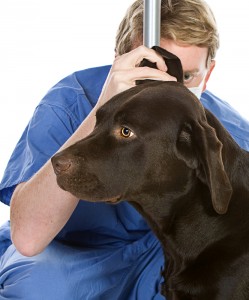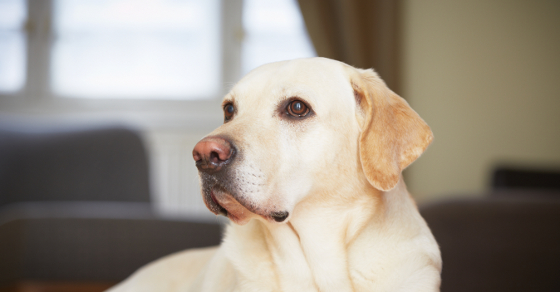Labradors can experience ear issues that can be quite troublesome for both them and their owners. This article will explore the common causes of ear problems in Labradors, including signs, symptoms, reasons, treatments, and prevention methods. When Labradors start shaking their heads or flapping their ears, it could indicate an ear infection. This article will delve into the reasons behind these infections, the typical ear problems that affect Labrador Retrievers, and useful tips to assist your dog. Cleaning your Labrador’s ears properly will also be discussed. It is not uncommon for Labrador Retrievers to suffer from ear infections and other ear-related issues. Their floppy ears are not designed for optimal health, unlike dogs with upright ears that allow for better air circulation. Floppy ears can trap heat and create a conducive environment for germs and other harmful substances to thrive. Labradors with narrow or excessively hairy ear canals may be at a higher risk of ear problems. Additionally, Labradors are prone to allergies that can contribute to ear issues. However, not all Labradors will be affected, so it is essential to recognize the signs of ear problems. Common signs of ear problems in Labradors include head shaking, ear flapping, and tilting of the head. These symptoms can cause discomfort for the dog, so knowing how to identify and address ear issues is crucial for their well-being.

Your furry friend might scratch his ears with his back feet or rub them with his front paw. He might also be seen dragging his ear along the floor. However, it’s easy to miss ear problems that can arise. To avoid this, take a peek at your dog’s ears occasionally. If you notice a dirty or inflamed look, along with excessive dark brown wax, it’s not a great sign. Neither is any unpleasant smell coming from their ears – a healthy dog’s ears should not have any odor.
Common causes of ear problems in Labrador Retrievers often stem from inflammation in the ear canal, known as Otitis. This inflammation is usually limited to the external ear, referred to as Otitis Externa by veterinarians. The underlying issue is often due to small organisms like ear mites, yeast, or bacteria taking up residence in the ear canal. Identifying the specific culprit can be tricky at first. Ear problems like Otitis Externa are commonly linked to atopic dermatitis and other allergies in dogs. Over half of dogs with atopic dermatitis also experience ear infections, while the majority of dogs with food allergies suffer from ear problems as well. Although these bugs are found in the ears of both healthy and affected dogs, the quantity may vary. If your Labrador Retriever is vigorously shaking its head, with ears flapping wildly, it might be due to ear mites. These tiny parasites resemble white crabs and can be visible to the naked eye or under a microscope when examined by a veterinarian. Ear mites feed off debris in the ear canal, like dead skin cells, and can cause significant irritation to the affected animal. Symptoms can vary, with some dogs scratching their ears excessively while others show little discomfort. Look for dirtiness and possibly an unpleasant odor in your dog’s ears as signs of ear mites.

Your veterinarian will need to confirm the diagnosis, and if you have multiple pets, such as dogs or cats, it’s important to treat them all as the issue can easily spread between them. Treating ear mites requires persistence as it takes a few weeks to completely get rid of the problem. Your vet will provide a localized treatment for the ears and may suggest using a flea/tick product for overall treatment. Don’t forget to treat your pet’s bedding for a more effective cure. Keep in mind that cat flea products can make cats sick, so make sure to use a specific product for your cat. Yeast or fungal infections are common in dogs, especially those with floppy ears like Labradors. Allergies can make dogs more prone to yeast infections. If your dog is itching or has a foul smell coming from their ears, it could be a yeast or bacterial infection. It’s essential to consult your vet for a proper diagnosis and treatment plan. It’s not a good idea to leave ear infections untreated as they can be distressing for the dog and may lead to more severe complications like a haematoma. Prevention is key to keeping your dog’s ears healthy, including good air circulation and regular cleaning. Trimming excess hair around the ears can also help prevent issues. Always follow your vet’s recommendations for cleaning and treatment to keep your dog’s ears in good condition.

How to properly clean a Labrador’s ears: Regularly cleaning your Labrador’s ears can help prevent potential ear problems. To do so, take a large cotton ball moistened with warm boiled water or a vet-recommended ear cleaner and gently wipe around the opening of the ear canal, only going as far as you can easily see. Avoid inserting anything into the ear canal itself, as this can push wax further inside and interfere with the natural cleaning process. What to do if you suspect an ear problem: If you suspect that your dog is experiencing an ear problem, it’s best to seek professional help from a veterinarian. While it may be tempting to try and treat the issue yourself, diagnosing the specific problem requires the expertise and tools of a vet. Early intervention by a vet can prevent the need for more invasive procedures on your dog’s ears down the line. For more information and resources on dog ear health, consider exploring the following references: – Zur G, 2002. Canine atopic dermatitis: University of California, Davis study. – Meury S, et all 2011. Environmental factors in the development of canine atopic dermatitis in Labrador and golden retrievers. – Zur G, 2011. Common causes of canine otitis externa and pathogens. – White R, & Pomeroy C 1990. Total ear canal ablation and lateral bulla osteotomy in dogs.
